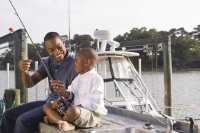
So this holiday season, how would it be if the Florida Fish and Wildlife Conservation Commission (FWC) put some more fish under the tree? Well, that is exactly what we have done for you all around the state.
The typical fish attractor in Florida is a cluster of hardwood trees, anchored by cinder blocks. State-constructed structures are marked with a bright yellow or white bouy so boaters and anglers know where they are. These attractors are strategically placed to congregate fish, making them more accessible to anglers.
Fishery managers have experimented with alternate materials such as evergreen trees, wooden pallets, stake beds, rock piles, gravel, concrete blocks, car tires and plastic fish-attracting devices. Studies comparing material types revealed variable results. Early data showed evergreen trees did not last as long as hardwood, and environmental and navigational concerns eliminated the use of car tires and concrete in most freshwater systems.
These attractors work by providing areas that algae can grow, which attracts insects that in turn bring small fish around to feed on the bugs. The small fish attract larger fish. The fact attractors also provide shelter for concealment makes the areas havens for a variety of fishes.
More recently, fisheries managers in Florida focused on comparing the productivity, longevity and cost of brush and plastic fish attractors. New models of plastic fish attractors look and act somewhat like natural trees. Preliminary results, from the first year of a three-year study, indicate plastic attractors are typically yielding more bass than brush attractors. So despite additional material cost, they may be the wave of the future, especially if they prove as durable as hoped, because brush attractors need to be frequently refurbished.
Results show anglers caught more fish around plastic attractors than either brush treatment in 68 percent of weeks sampled. In four of six sample areas, anglers caught more bass near plastic, and the four attractors with the highest catch rates were all plastic. Of 197 total bass caught, 78 percent were caught on crankbaits and 99 lures were lost but only 10 percent of those were on plastic attractors. Moreover, in the last 10 weeks, no lures were lost on plastic attractors, as anglers learned to recover them.
Fishery biologists also conducted electrofishing surveys, where an electric current temporarily stuns fish and allows them to be collected, counted and live released. The number of bass was similar near brush and plastic attractors. Therefore, plastic and natural trees may concentrate similar numbers of bass, but bass near plastic attractors may be more vulnerable to angling. Plastic and brush also concentrated similar numbers of black crappie.
The FWC operates under a permit from the Department of Environmental Protection when placing attractors in public waters. A permit is also needed by individuals or organizations to place natural or artificial attractors in public waters or lakes owned by two or more parties. Apply for permits from DEP and/or the local water management district. Litter laws also apply to depositing materials in public waters.
The FWC still constructs gravel or shell attractors that create excellent spawning substrate for sunfish, including bass, bream and crappie. These effectively concentrate fish during spring in areas that otherwise have mostly muddy bottoms.
For coordinates to more than 150 attractors in public waters around the state, go to MyFWC.com/Fishing and under “Freshwater Fishing” select “Fishing Sites/Forecasts” then “Fish Attractors.” Click the map for an interactive tool. A video of hardwood fish-attractor construction is also available, along with more information about freshwater attractors.
Fish attractors aren’t the only way the FWC is putting more fish under the “tree” for you! Stocking programs, habitat enhancement and special regulations contribute to fishing success. These efforts are funded in part by fishing license sales. Other funds come from a fee on the sale of fishing tackle and motor boat fuels, which is collected at the national level and returned to the states for Federal Aid in Sport Fish Restoration projects.
Consider purchasing a “Go Fishing” largemouth bass tag for fishing enthusiasts’ vehicle or boat trailer (see BuyAPlate.com). The Department of Highway Safety and Motor Vehicles issues specialty license plate gift certificates that allow anyone to purchase a specialty license plate as a gift for a motor vehicle registrant. The bass tag directly supports FWC efforts to improve fishing in Florida.
Another useful gift idea is to help bass anglers register at TrophyCatchFlorida.com and buy them a fishing scale. Just registering enters them in a drawing for a $40,000 Phoenix bass boat. Everytime they take a photo of an eight-pound or heavier bass on the scale, submit it according to the rules and release it, they’ll earn at least $100 in gift cards, club shirts, decals and certificates – all year long.
A Florida fishing license also makes a great gift. Visit License.MyFWC.com, where you will find licenses for residents and visitors, and a youth fishing license that is good until they turn 17, locking in the price and bragging rights as a card-carrying sportsman.
A Lifetime Sportsman License for Florida children and young adults covers hunting, and freshwater and saltwater fishing! The license is available through Dec. 31 for about half its usual price. So for a limited time you can buy it for $500 plus processing fees. It can be purchased for Florida residents ages 5 to 21 online, by calling 888-347-4356 or at local tax collectors’ offices. For details, go to License.MyFWC.com.
This article originally appeared on Santa Rosa Press Gazette: Many holiday goodies available – some under the fish attractor ‘tree’
